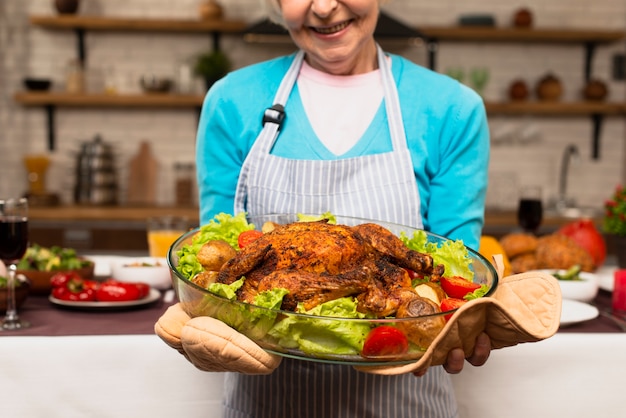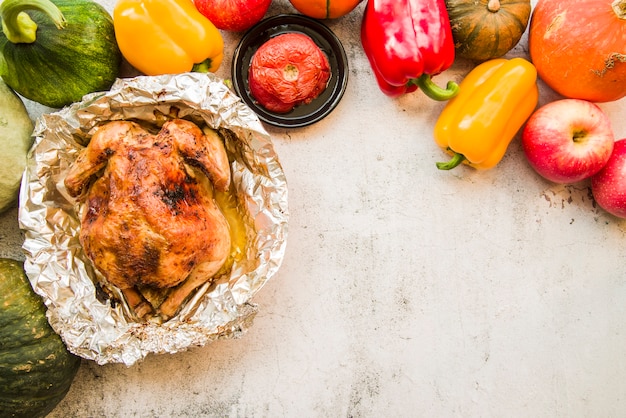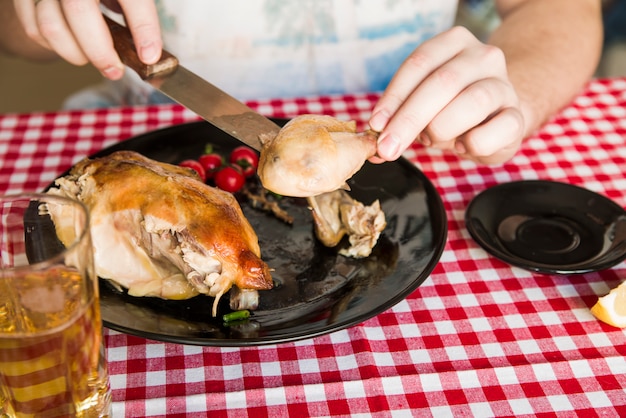Right, let's talk turkey, shall we? No, not that kind of talk - we're talking about the real deal, the star of any festive feast, the magnificent bird that brings families together (and sometimes causes a bit of a commotion in the kitchen).
I've been cooking turkeys for years, and let me tell you, it's an adventure. There's always a little something unexpected - a rogue gravy splash, a slightly over-cooked breast, or a last-minute scramble to get everything on the table. But the joy of a perfectly cooked turkey, bursting with flavour and juicy to the bone, is worth every bit of the effort.
This guide is your roadmap to turkey triumph. From choosing the right bird to mastering the stuffing and perfecting the gravy, we're going to cover it all, with a few tips and tricks I've picked up along the way. So grab your apron, put on your favourite playlist, and let's get cooking!
(Part 1) Picking the Perfect Bird

The first step to a delicious turkey is choosing the right one. This isn't a decision to be taken lightly, my friend. You've got to get your hands on a bird that's going to satisfy your cravings and impress your guests.
Size Matters
The first thing to consider is size. How many people are you feeding? A general rule of thumb is about 1 pound of turkey per person. However, if you're planning on leftovers (and who isn't?), you might want to go for a slightly larger bird. For a small gathering of 4-6 people, a 10-12 pound turkey should suffice. If you're expecting a crowd of 10 or more, a 14-16 pound bird will ensure everyone gets their fill.
Fresh or Frozen?
Next up: fresh or frozen? Both have their pros and cons. Fresh turkeys are generally more expensive but offer a better flavour and texture. The flavour is more intense, the meat is more tender, and you don't have to worry about thawing it. frozen turkeys, on the other hand, are more readily available and allow you to plan ahead. They are often more affordable and are readily available year-round, making them a practical choice for many. Just make sure to defrost it properly before cooking, giving it plenty of time to thaw in the fridge.
Look for the Good Stuff
When you're at the butcher's, have a good look at the bird. You want a turkey with a plump, full breast, smooth skin, and a good layer of fat. This fat will help keep the turkey moist during cooking. Avoid any birds that have a slimy texture or a strong odour. This indicates that the turkey may not be fresh.
Don't Forget the Extras!
While you're at it, don't forget the extras - the giblets, neck, and wings. These are essential for making a delicious turkey stock, which is a must-have for gravy and stuffing. The giblets, which are the heart, liver, and gizzards, add a rich flavour to the stock. The neck and wings can be added to the stockpot for extra flavour and body.
(Part 2) Prepping the Turkey

Now that you've got your beautiful bird, it's time to get ready for the big day. This is where the real fun begins, and a little prep goes a long way.
The Rinse
First, give your turkey a good rinse inside and out with cold water. This will remove any loose feathers or impurities. Pat it dry with paper towels. Be gentle when handling the turkey to avoid tearing the skin.
The Brine
Now, for the big decision: to brine or not to brine? Brining is a technique that involves soaking the turkey in a salt water solution for several hours or even overnight. This helps to lock in moisture and create a juicier, more flavorful turkey. I'm a big fan of brining, especially for larger birds, as it ensures even cooking and prevents dryness. A basic brine is simply salt and water, but you can add herbs, spices, and even citrus for added flavour.
The Butter Rub
Once the turkey is dry, it's time to give it a little TLC with a butter rub. This will add flavour and keep the skin crispy. I like to use a combination of unsalted butter, herbs, and spices like garlic powder, onion powder, paprika, and thyme. Rub it all over the turkey, making sure to get under the skin to season the meat. This is called "butterflying" the turkey.
The Stuffing
Now for the stuffing! This is where the creativity really comes into play. There are endless possibilities for stuffing, from classic bread-based recipes to more modern veggie-packed options.
(Part 3) The Art of Stuffing
Stuffing is like the soul of the turkey. It’s that element that brings warmth, flavour, and a whole lot of comfort to the festive table. It’s a crucial part of the turkey cooking process, so we need to get it right.
The Classic Bread Stuffing
Let’s start with the classic: bread stuffing. This one’s a bit of a family tradition for me. My grandmother used to make it with stale bread cubes, sautéed onions and celery, fresh herbs, and a touch of poultry seasoning. It was simple, hearty, and always a hit. The stale bread absorbs the moisture from the broth and creates a fluffy texture.
Beyond the Bread
Now, let’s not limit ourselves to bread. We can get creative with our stuffing and explore different flavours and textures. Think wild rice, quinoa, couscous, or even polenta. You can incorporate dried fruits like cranberries or apricots for a touch of sweetness. These alternatives offer a different flavour profile and texture than traditional bread stuffing.
Seasoning is Key
Regardless of the base you choose, remember the seasoning is crucial. Experiment with herbs and spices like sage, rosemary, thyme, parsley, and even a pinch of nutmeg. Don’t be afraid to let your culinary creativity run wild. The right combination of herbs and spices can elevate your stuffing from ordinary to extraordinary.
Moistness Matters
Don’t forget about the moisture. You want a stuffing that’s moist but not soggy. Add broth or stock gradually to the mixture, just enough to bind the ingredients without turning it into a soup. You can use chicken, turkey, or vegetable broth for a flavourful stuffing.
Don’t Overstuff
And lastly, a word of caution. Don’t overstuff the turkey. It’s best to fill it generously, but leave some space for the stuffing to expand during cooking. Overstuffed turkeys can cook unevenly and make it difficult to achieve a consistent temperature throughout.
(Part 4) cooking time

Okay, we’re ready for the main event. This is the moment we’ve been working towards – cooking the turkey to perfection. It’s a bit of a balancing act, but with the right techniques and a little patience, you’ll have a delicious turkey ready for the table.
The Oven Temperature
First things first: set your oven to 325 degrees Fahrenheit (160 degrees Celsius). This is the ideal temperature for roasting a turkey and ensures even cooking. Preheating the oven is essential for achieving the correct temperature for roasting.
The roasting time
Now, for the roasting time. This depends on the size of your turkey. A good rule of thumb is to cook it for 15 minutes per pound. For a 12-pound turkey, you’re looking at about 3 hours. It's important to check the turkey's internal temperature with a meat thermometer to ensure it is cooked to a safe temperature.
The Resting Time
Once the turkey is cooked, don’t rush to carve it. Let it rest for at least 30 minutes before carving. This allows the juices to redistribute, resulting in a juicier and more flavorful turkey. Cover the turkey loosely with foil to prevent it from drying out while it rests.
The Basting
During the cooking process, remember to baste the turkey with pan drippings or broth every 30-45 minutes. This helps keep the skin moist and adds flavor. Use a basting spoon or brush to evenly distribute the drippings over the turkey.
The Meat Thermometer
The ultimate test for turkey doneness is the meat thermometer. It should register 165 degrees Fahrenheit (74 degrees Celsius) in the thickest part of the thigh, without touching the bone. This ensures that the turkey is cooked through and safe to eat.
(Part 5) Carving the Turkey
The turkey is cooked, it’s rested, and now it’s time for the grand finale – carving the bird. This is where the anticipation builds, and everyone’s gathered around, waiting for that first slice of delicious turkey.
The Tools
You’ll need a sharp carving knife, a carving fork, and a cutting board. A sharp knife will make carving easier and cleaner. The carving fork helps to secure the turkey while you cut.
The Process
Start by removing the legs. Use the carving fork to hold the turkey steady and cut through the joint at the top of the thigh. You may need to use your knife to separate the skin from the leg.
Next, remove the wings by cutting through the joint at the shoulder. The wings can be easily removed by twisting and pulling.
Now, move onto the breast. Cut along the breastbone, separating the two breasts. The breastbone can be easily identified by its long, flat shape.
Once the breasts are separated, cut across the grain into thin slices. This will prevent the turkey from being tough and stringy.
Finally, cut the legs into smaller pieces. You can cut the thighs and drumsticks separately for easier serving.
The Presentation
Arrange the carved turkey on a platter, surrounded by your favourite side dishes. You can also use the turkey bones to make a delicious stock for your gravy. The bones will add depth of flavour to the stock.
(Part 6) The Gravy
A delicious turkey isn’t complete without a rich and flavorful gravy. It’s the perfect finishing touch that brings all the elements together.
The Pan Drippings
The key to great gravy is the pan drippings. Once the turkey is removed from the oven, pour the pan drippings into a fat separator. This will separate the fat from the flavorful drippings. You can also use a spoon to skim the fat from the pan drippings.
The Roux
Next, make a roux, which is a mixture of flour and fat. You can use the fat from the pan drippings or butter. Cook the roux over medium heat until it’s golden brown. This will create a rich and flavorful base for the gravy.
The Broth
Now, whisk in your favourite broth, whether it’s chicken, beef, or turkey. Bring the mixture to a boil, then reduce the heat and simmer until thickened. The broth adds flavour and moisture to the gravy.
The Seasoning
Season the gravy with salt, pepper, and any other herbs or spices you like. I often add a pinch of thyme or rosemary for extra flavor. A touch of fresh herbs can elevate the flavour of the gravy.
The Finishing Touches
Strain the gravy through a fine-mesh sieve to remove any lumps. Serve hot over your turkey and side dishes. You can also add a splash of red wine or sherry to the gravy for an extra layer of complexity.
(Part 7) Side Dishes to Pair with Your Stuffed Turkey
Now that we've got the star of the show sorted, let's talk about the supporting cast – the side dishes that complement the turkey and create a truly memorable feast.
Classic comfort foods
No turkey dinner is complete without classic comfort foods like mashed potatoes, stuffing, gravy, and cranberry sauce. These dishes are timeless favourites for a reason, and they provide the perfect balance of creamy, savory, and sweet flavours. The mashed potatoes offer creamy richness, the stuffing provides savoury flavour, the gravy adds a touch of moisture, and the cranberry sauce offers a sweet contrast.
Roasted Vegetables
For a touch of freshness and vibrant colour, add roasted vegetables like Brussels sprouts, carrots, asparagus, or butternut squash. Roasting brings out the natural sweetness of the vegetables and adds a satisfying crunch to the meal. These roasted vegetables add a visual appeal and nutritional value to the table.
green beans with Almonds
Green beans with toasted almonds are a classic side dish that adds a touch of elegance and nutty flavour. They're easy to prepare and can be made ahead of time, freeing up your kitchen time on the big day. The combination of green beans and almonds creates a textural contrast, while the almonds add a nutty flavour.
sweet potato Casserole
sweet potato casserole is another crowd-pleaser that brings a sweet and comforting element to the table. You can get creative with toppings like marshmallows, pecans, or a sprinkle of cinnamon. The sweet potato casserole is a comforting and satisfying dish that can be enjoyed by all.
Salads
For a lighter touch, consider adding a salad to your spread. A simple green salad with vinaigrette dressing or a cranberry salad with pecans can offer a refreshing contrast to the heavier dishes. These salads add a touch of freshness and balance to the meal.
(Part 8) Leftover Turkey Magic
So, the big day has come and gone, and you're left with a mountain of leftover turkey. But don’t despair! Leftovers are a culinary opportunity, a chance to get creative and transform your turkey into a whole new set of delicious dishes.
turkey sandwiches
Let's start with the obvious: turkey sandwiches. These are a classic for a reason. Pile on your favourite toppings, such as mayonnaise, lettuce, tomato, and cheese, and you’ve got a satisfying meal. You can also use leftover stuffing as a sandwich filling.
turkey soup
Transform your leftovers into a hearty and comforting turkey soup. Use leftover turkey, broth, vegetables, and noodles for a satisfying and flavourful soup. You can also add leftover stuffing for added flavour and texture.
turkey salad
Combine your leftover turkey with mayonnaise, celery, onion, and herbs for a delicious turkey salad. Serve it on bread, crackers, or lettuce leaves. You can also add cranberries, pecans, or Dijon mustard for added flavour.
Turkey Pizza
For a fun and creative twist, use your leftover turkey to create a delicious turkey pizza. Top the pizza with turkey, cheese, and your favourite veggies. You can also use a pre-made pizza crust for convenience.
Turkey Curry
For a change of pace, make a flavourful turkey curry. Combine leftover turkey with curry paste, coconut milk, and vegetables. You can also add a touch of sweetness with honey or sugar.
(Part 9) FAQs
What if my turkey is dry?
Ah, the dreaded dry turkey! Don’t worry, we’ve all been there. If your turkey turns out a bit dry, you can help to compensate by adding extra gravy or sauce to your plates. You can also try making a turkey sandwich, as the bread helps to absorb moisture. If you have leftover stuffing, you can also add it to the turkey sandwich for extra flavour and moisture.
How can I prevent my stuffing from being soggy?
The key to preventing soggy stuffing is to ensure it’s not packed too tightly in the turkey. Leave some space for the stuffing to expand and cook evenly. You can also add a little extra broth to the stuffing, but don’t overdo it. You can also use a bread that is slightly stale for stuffing, as it will absorb less moisture.
Can I freeze leftover turkey?
Yes, you can freeze leftover turkey. Wrap it tightly in plastic wrap or aluminum foil, and store it in a freezer-safe container. It should last for several months. When you're ready to use it, thaw it in the refrigerator overnight.
What are some tips for making the turkey skin crispy?
For crispy turkey skin, be sure to pat the turkey dry before roasting. You can also use a high-heat setting for the first 30 minutes of cooking to help the skin crisp up. Another trick is to elevate the turkey on a rack so that air can circulate around it. This will help to prevent the skin from becoming soggy.
How can I tell if my turkey is cooked through?
The best way to tell if your turkey is cooked through is to use a meat thermometer. It should register 165 degrees Fahrenheit (74 degrees Celsius) in the thickest part of the thigh, without touching the bone. If you don’t have a meat thermometer, you can check the turkey by making a small incision in the thickest part of the thigh. The juices should run clear, not pink. If the juices are still pink, the turkey needs to cook longer.
(Part 10) Conclusion
There you have it, a complete guide to cooking a delicious stuffed turkey. It’s not always easy, but the rewards are worth it. Remember, the key is to choose a good quality bird, prep it properly, and cook it with patience. And don’t be afraid to experiment with flavours and techniques. The more you cook, the more confident you’ll become. So go forth, embrace the challenge, and enjoy the delicious results! Happy cooking!
Everyone is watching

How to Cook Frozen Lobster Tails Perfectly: A Step-by-Step Guide
RecipesLobster. Just the word conjures up images of lavish meals, special occasions, and a taste of luxury. But let's...

Pigs in a Blanket Cooking Time: How Long to Bake for Perfect Results
RecipesAh, pigs in a blanket. Just the name conjures up images of those delightful little parcels of crispy pastry en...

Pork Fillet Cooking Time: How Long to Cook It Perfectly
RecipesPork fillet, or tenderloin as it's sometimes called, is a real favourite in our house. It's so versatile, and...

The Ultimate Guide to Tender, Juicy Pulled Pork
RecipesRight, let's talk pulled pork. It's one of those dishes that just screams "comfort food," doesn't it? I mean...

The Ultimate Guide to Cooking Sweet Potatoes: From Roasting to Mashing
RecipesSweet potatoes. Just the name conjures up images of warm, comforting dishes, bursts of vibrant color, and a to...
